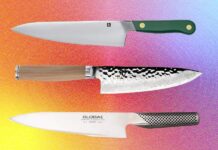A chef’s knife is arguably the most important tool in any kitchen, serving as the primary instrument for slicing, dicing, and chopping with precision. Despite advances in kitchen technology—from smart ovens to AI refrigerators—the fundamental need for a reliable, sharp knife remains constant. However, the “best” knife isn’t universal; it depends on individual preferences, hand size, cooking style, and whether you’re left- or right-handed.
This guide details our extensive testing of nearly two dozen chef’s knives to identify top picks for various cooks, from beginners to professionals. We’ve evaluated factors like blade material, construction, comfort, and performance to help you choose the right tool for your kitchen.
Why a Good Chef’s Knife Matters
The choice of a chef’s knife isn’t just about convenience; it impacts efficiency, safety, and even the enjoyment of cooking. A dull knife requires more force, increasing the risk of slips and injuries. A sharp, well-balanced knife reduces fatigue, improves control, and makes food preparation faster and more accurate.
The market offers a wide range of options, from budget-friendly models to high-end Japanese blades, making the selection process overwhelming. Our testing aims to cut through the noise and provide clear recommendations based on real-world performance.
Our Top Picks
After hours of slicing, dicing, and chopping, here are our standout chef’s knives:
- Hedley & Bennett Chef’s Knife ($120): Best overall for most cooks. This knife features a three-layer Japanese steel construction (AUS10 core with SUS1A-1 outer layers) and a comfortable grip. Its 8-inch blade offers versatility for various tasks, making it ideal for beginners and experienced chefs alike.
- Shun Premier Blonde 6-Inch Chef’s Knife ($200): Our favorite Japanese option. This knife boasts a micro-thin, high-carbon Damascus stainless steel blade with a 16-degree edge. Its lightweight design and exceptional sharpness make it perfect for precision work, though it requires more careful handling.
- Misen 8-inch Chef’s Knife 2.0 ($94): A solid performer for longer, precise cuts, made from Japanese high-carbon stainless steel with a high chromium content to resist rust.
Knife Comparison Table
| Blade Material | Made In | Blade Length | Total Length | Edge Angle | Blade Hardness | Total Weight |
|---|---|---|---|---|---|---|
| Hedley & Bennett (AUS10/SUS1A-1) | China | 8 inches | 12.8 inches | 11.5 deg. | 60 HRC | 0.40 lbs |
| Zwilling Four Star (High-carbon special steel) | Germany | 7.87 inches | Nearly 13 in | Fine V | 55–58 HRC | 0.44 lbs |
| Shun Premier Blonde (Damascus stainless steel) | Japan | 6 inches | 12 inches | 16 deg. | 60–61 HRC | 0.3 lbs |
Honorable Mentions
- New West Knifeworks Joy Bauer 6-Inch Chef Knife ($225): Visually striking with a red-and-white handle, but food tends to stick during use.
- Henckels Classic Precision 7-Inch Santoku Knife ($80): A more affordable Santoku option with a flat blade, effective for slicing and chopping.
- Material the 8-Inch Knife ($105): A heavier, versatile knife that minimizes food sticking and offers exceptional durability.
Maintaining Your Chef’s Knife
A sharp knife is a safe knife. Regular sharpening is crucial to maintaining performance and preventing accidents. Dull knives require more pressure, increasing the risk of slips. While pull-through sharpeners offer convenience, professional chefs recommend water stones (like Shapton stones) for carbon steel blades. Honing steels or leather strops should be used between sharpenings to maintain edge alignment.
Do You Need a Knife Set?
No. Knife sets are often overpriced and include unnecessary blades. Invest in a high-quality chef’s knife, a paring knife, and a serrated knife for bread. A solid chef’s knife will cover 90% of your kitchen needs.
The Bottom Line
Choosing the right chef’s knife is an investment in your culinary experience. Prioritize sharpness, balance, and comfort to ensure efficiency and safety in the kitchen. Whether you opt for a Japanese precision blade or a rugged German workhorse, the key is to find a tool that fits your needs and cooking style.



























